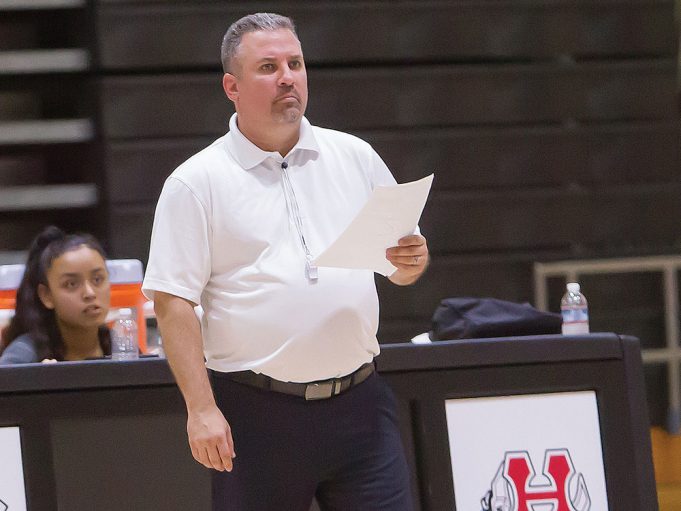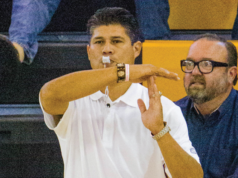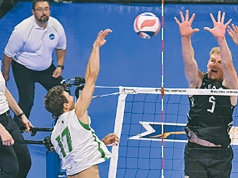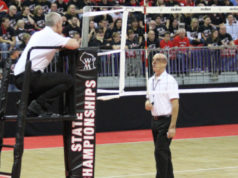To the casual fan, the role of the second referee can appear to be minor: check lineups, call nets and manage timeouts and substitutions. To those in the know, however, the role of the second referee is a set of complex tasks and responsibilities that only grow more demanding as the modern game of volleyball continues to evolve.
There has been a significant increase of close plays occurring within or near the attack zones. As sets to the back-row players become more frequent options in offenses instead of being used only as bailouts, the second referee needs to be able to provide assistance to the first referee more often, without sacrificing any primary responsibilities. Developing routines and understanding where to focus at different points in a rally are important tools that allow the second referee to achieve success.
At the beginning of a rally, but prior to the contact of the serve, the second referee’s focus is on the receiving team’s serve receive pattern. At that time the traditional primary focus is on potential alignment issues. But the task has evolved greatly from concentrating on just whether or not the players are in a legal position on the floor. The second referee’s advanced responsibilities have expanded into learning to identify the potential back-row hitters during that process. As team offenses become faster, it becomes more important to identify all of the hitters.
Upon contact of the serve, the second referee transitions to the blocking side. For a number of years, referees were trained to “see the play develop.” That was interpreted to mean delay the transition until the setter sets the ball. Not true. Second referees should begin their movement to the blockers’ side when the server contacts the ball and then quickly transition to each blocking side as the rally continues to see the play develop from there. As a quick self-check during play, ask yourself the question: “Have I finished my transition so that I am in a stationary position and can observe the pass coming down into the setter’s hands?” If the answer is no, your transition is likely too slow.
Pick up on cues that allow the second referee to know where to focus
What exactly does “see the play develop” mean and why does it matter? It means picking up cues that allow the second referee to know where to focus attention. That starts with a position and posture that allows you to see the greatest amount of court with the least movement. Your position should be slightly angled toward the net — think shoulders, hips and toes facing through the net to the three-meter line on the opposite side. That position allows you to have a broad focus to not only see the setter release the ball but also pick up back-row players beginning their approach patterns. If the team is running a fast back-row set, we should consider putting our primary focus on the back-row player and pick up the setter peripherally. That would allow you to better assist the first referee with attack line faults during a fast-paced match.
Using the cues we pick up from seeing the play develop allows you to focus your attention where it needs to be: the attack line for a back-row attack, the top of the net for a tight pass or the location along the net where an attack (and possibly a net fault) might occur. Adjusting our focus requires a couple of decisions to be made very quickly. The first is, “Do I need to make a secondary transition?” A secondary transition is a small step forward, backward or to one side to have a good line of sight for the developing play. However, be sure to move with a purpose — the addition of secondary transition to the referees’ vocabulary has often resulted in unnecessary movement under the belief that it is required on all rallies. Instead of “secondary transition,” think “necessary adjustment.” If the second referee’s current position does not provide a view of the focal point of the play, make the necessary adjustments (movements), keeping in mind to complete those adjustments and be stationary when the ball contact/play actually occurs.
The second decision is, how does the second referee see what needs to be judged? The answer to that lies in knowing where to look, which is based on experience and knowledge of the game and in practicing basic eye-movement patterns. For second referees, the fundamental eye-movement pattern is:
• Watch the blockers move along the net to where the attack will occur.
• As the blockers begin to jump, track their movement from their takeoff point up along the body of the net to the top of the blockers’ hands at the height of their jump.
• As the blockers begin to land, track their movement from the top of their hands down along the body of the net to the centerline and stay focused on the centerline until all blockers and attackers have stepped away and centerline faults are no longer possible.
That eye-movement pattern will cover the issues of net and centerline faults. Assisting with other situations such as attack line faults and tight passes to the net are simply built upon that foundation: focus on the three-meter line or top of the net and, if the rally continues, simply pick up with your basic eye movements.
Second referees have a lot of movements to track and decisions to make, in very short periods of time. Skilled second referees make that look easy by having good position, picking up cues as the play develops and utilizing efficient eye patterns.
What's Your Call? Leave a Comment:
Note: This article is archival in nature. Rules, interpretations, mechanics, philosophies and other information may or may not be correct for the current year.
This article is the copyright of ©Referee Enterprises, Inc., and may not be republished in whole or in part online, in print or in any capacity without expressed written permission from Referee. The article is made available for educational use by individuals.


















